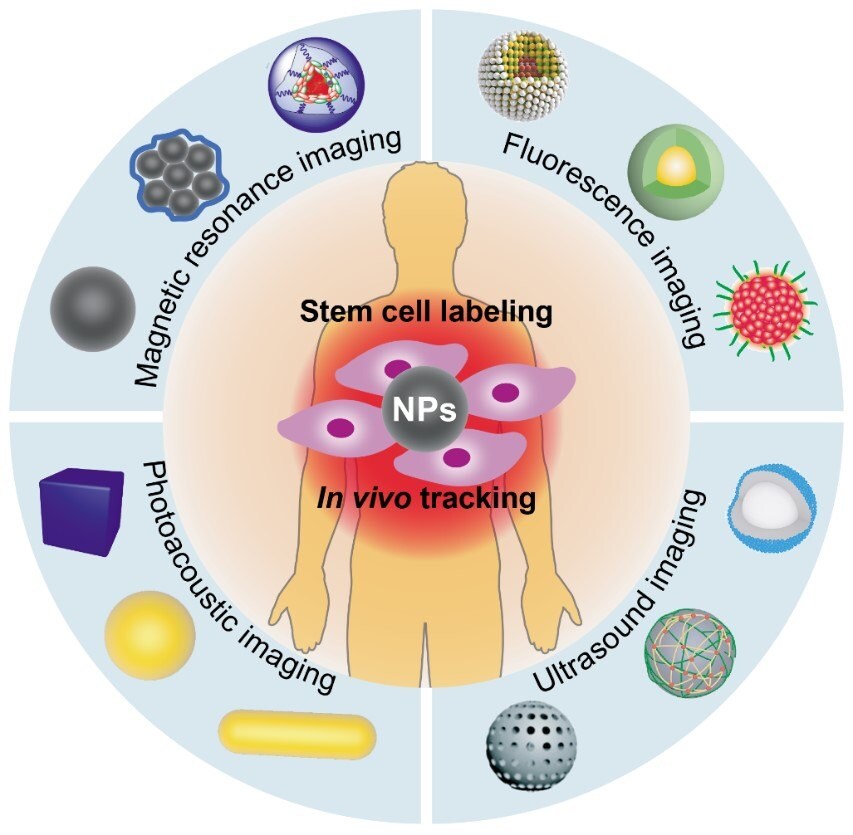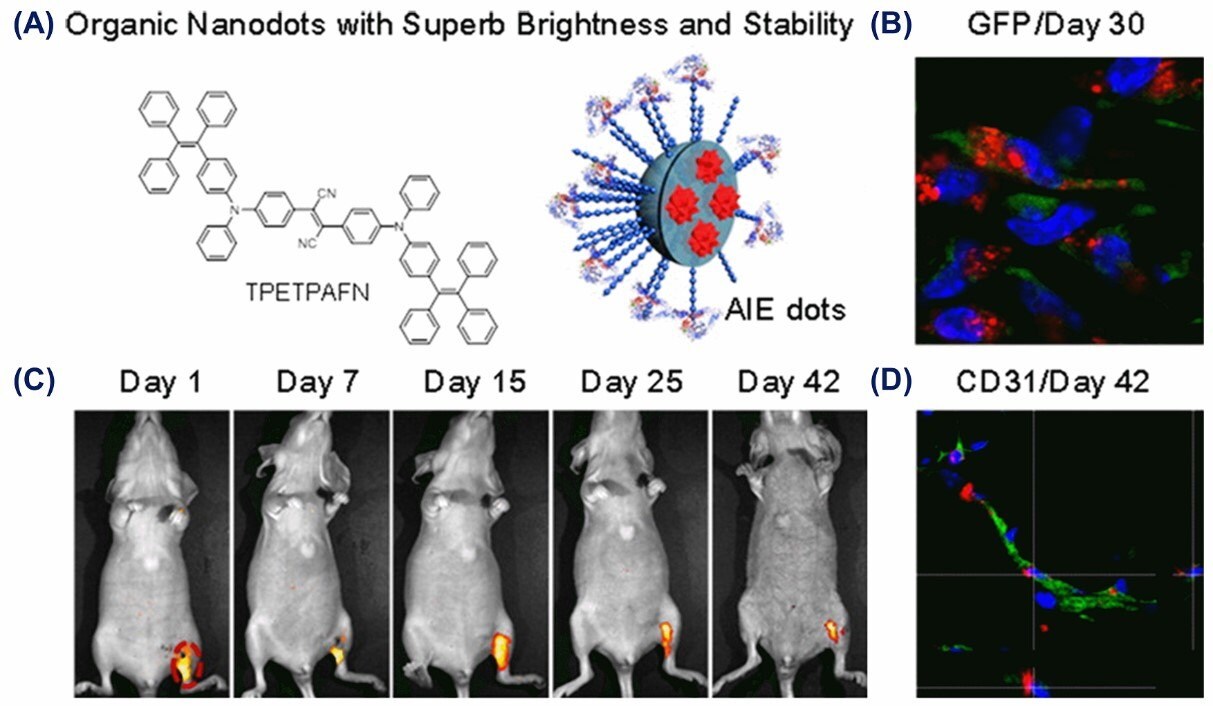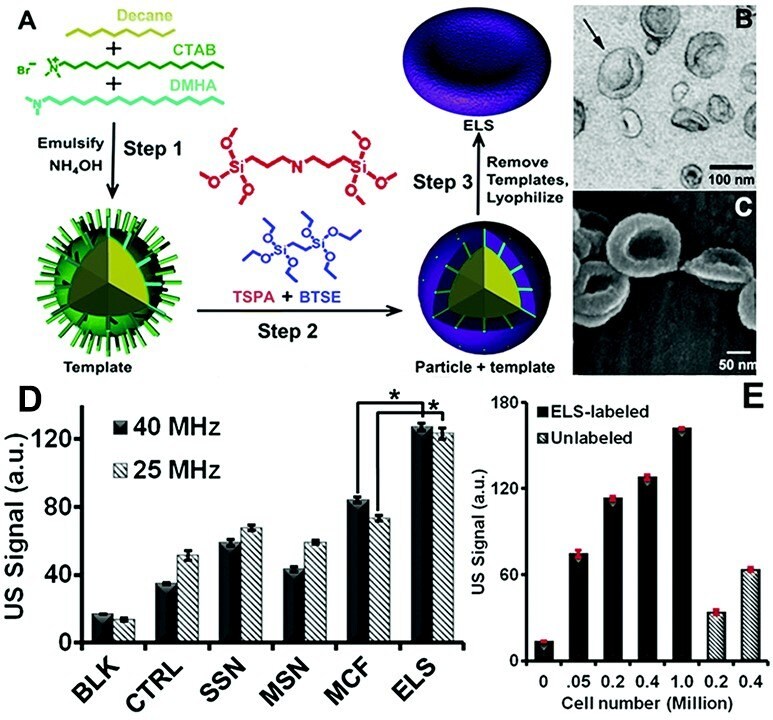Recent Advances on Nanoparticle-Based Imaging Contrast Agents for in Vivo Stem Cell Tracking
Chang Xu, Qishuai Feng, Peng Ning, Zhenguang Li, Yao Qin, Yu Cheng
Translational Medical Center for Stem Cell Therapy & Institute for Regenerative Medicine, Shanghai East Hospital, Tongji University School of Medicine, Shanghai
Material Matters™, 2021, 16.2 | Material Matters™ Publications
Introduction
With their great potential in tissue engineering, regenerative medicine, and homing effect, stem cell therapies are promising strategies for treating many incurable diseases, such as Parkinson’s disease, liver failure, ischemic heart disease, and cancer. The cell distribution state, migration behaviors, and functionality after engraftment cannot be well elucidated due to a lack of effective in vivo tracing methods, thus impeding the clinical transformation of stem cell therapies. Developing more advanced imaging strategies to label and track transplanted stem cells without affecting their normal physiological functions is necessary to reveal their therapeutic mechanisms and evaluate their safety before clinical trials. The ideal imaging techniques for stem cells should be non-toxic and high-resolution, have an extended life, and dynamically provide the cell fate information. A variety of bioimaging strategies have been developed over the past few years. One promising strategy uses well-designed nanoparticles as contrast agents to track stem cells, due to their distinguished physiochemical properties as well as their designability and versatility. Despite this, the existing imaging methods cannot satisfy all the in vivo stem cell tracking requirements. Herein, we provide a brief review of the four most commonly used nanoparticle-based imaging modalities for stem cell tracking: magnetic resonance imaging (MRI), fluorescence imaging, ultrasound imaging (USI), and photoacoustic imaging (PAI) (Figure 1). Special attention is paid to the design of contrast nanoagents, the corresponding imaging mechanism, and the issues these nanoagents have resolved. This serves to shed light on the future design and fabrication of more advanced contrast agents, approaching an ideal one for tracking transplanted stem cells in vivo.

Figure 1.Various contract nanoagents designed for magnetic resonance imaging, fluorescence imaging, ultrasound imaging, and photoacoustic imaging modalities in stem cell tracking in vivo.
Magnetic Resonance Imaging (MRI)
Magnetic resonance imaging (MRI) is the preferred method for in vivo stem cell imaging due to its unique features, including no penetration depth limitation, excellent spatial (40 to 100 µm) and temporal (minutes to hours) resolution, and safe operation.1 There are two categories of MRI: T1/T1*or T2/T2*- weighted MRI, based on the relaxation time of the longitudinal (T1) and transverse (T2) components of the magnetization vector towards equilibrium under the applied magnetic field. MRI contrast agents, including gadolinium (III) chelates and superparamagnetic iron oxide nanoparticles (SIONPs), are introduced to achieve a higher resolution and enhance the signal intensity by altering the relaxation times of surrounding water protons.2 Gadolinium(III) chelates are effective T1 contrast agents because they shorten the longitudinal relaxation rate (T1) and increase positive contrast on T1-weighted MRI sequences. As a T2 contrast agent, SIONPs have widely been applied in the field of MRI-based cell tracking to provide negative contrast by shortening the T2/T2* relaxation time. In the following section, nanoparticle-based contrast agents with clinical or commercial proof are reviewed for use in applications in stem cell tracking.
The fundamental requirements for nanoparticle-based stem cell labeling agents include colloidal stability, non-toxicity, high magnetism, and labeling efficiency. Colloidal stability in aqueous solution was typically obtained using hydrophilic polymer coatings, such as chitosan, dextran, PEG, etc. Margarita Gutova et al. reported a preclinical study where neural stem cells (NSCs) labeled with dextran coated ferumoxytol (FDA approval SIONPs) were transplanted into the patients with brain tumors3 NSC distribution was steadily and continuously tracked at multiple points for 12 weeks, followed by surveillance serial MRI.3 High labeling efficiency can also be obtained by modifying the particle surface to have a positive charge or specific ligands. For example, compared to ferumoxytol itself, self-assembling ferumoxytol nano-complexes modified with heparin and protamine sulfate, which reversed the negative charge of the original particle, showed higher labeling efficiency, and a threefold increase in T2 relaxivity. This modification strategy displayed in vivo MRI detection of at least 1,000 HPF-labeled cells implanted in rat brains.4 In addition, clinically approved Gd-DTPA wrapped with cationic liposomes could assure a highly efficient uptake of Gd and excellent intracellular retention in mesenchymal stem cells. Gd-DTPA-liposomes complex contrast agent made 500,000 labeled stem cells clearly visible for at least 2 weeks on a 3.0 T clinical scanner, thus overcoming the relatively low MRI sensitivity of Gd-DTPA.5
Monitoring migration and survival of stem cells are critical for therapeutic efficacy and safety assessments. For tracking stem cell migration, Lili Jiang et al. found that T2*-weighted MRI could monitor the migration of implanted pluripotent stem cells labeled with SIONPs (Merck KGaA, Darmstadt, Germany) from the injection site to the injured brain areas over 4 weeks.6 In evaluating cell survival, Ashok J. Theruvath et al. reported ferumoxytol-labeled apoptotic matrix-associated stem cell implants (MASIs) showed a significant loss of iron signals and longer T2 relaxation time viable 2 weeks after implantation in a cartilage repair process.7 When combined with a histopathologic examination, a ferumoxytol-based contrast agent can act as an indicator of the living or dead stem cells.
According to specific tissues, organs, and diseases, the stem cell tracking window ranges from several days to months. The strategy for in vivo tracking stem cells requires assessing the distribution, migration, and differentiation of the cells, as well as the efficacy and safety of cell implantation. Despite the rapid development in nanoparticle-based MRI for stem cell tracking, some challenges remain, such as imaging the differentiation and function of stem cells, combining MRI contrast agents with reporter genes, and coupling MRI with other noninvasive imaging tools.
Fluorescence Imaging
Fluorescence imaging is a classical optical imaging technology. Although being low cost and highly sensitive, it has poor tissue penetration (<1 cm) when compared to MRI technology. A solution to this issue is to tune the fluorophore or fluorescent protein to be excited in the near-infrared (NIR) range for deeper infiltration. However, the severe photo-bleaching and light scattering limits the tracking time and efficiency.8 The development of fluorescent nanoparticles (NPs) has improved the ability of fluorescent imaging in long-term tracing stem cells in vivo.
Quantum dots (QDs) are a series of classical inorganic semiconductor NPs for cell labeling.9 QDs optical abilities are based on the transition behaviors of excited electrons between different energy levels, which can be modulated via manipulating the material components or compositions to realize the NIR emission.
For example, CdSe/ZnS core/shell structures were designed to label and trace adipose tissue-derived stem cells (ASCs) in C57BL/6 mice models under NIR emission.10 By changing the bandgap, the material design can significantly improve the optical properties of the QDs.11 Wang et al. combined a NIR-II fluorescence QDs of Ag2S with classical bioluminescence red firefly luciferase (RFLuc) to label human mesenchymal stem cells (hMSCs). They studied the dynamic tracking of the survival and osteogenic differentiation of the transplanted hMSCs in a calvarial defect mouse model in a wide window of 400–1700 nm.12 Up-conversion nanoparticles (UCNPs), which depend on the shining mechanism of the anti-Stocks process through absorbing several NIR photons to generate one single short-wavelength photon, have also been used to label and track mouse MSCs.13,14 Nevertheless, heavy metal ions in QDs and rare earth metal ions doped in UCNPs are potential safety hazards for clinical stem cell tracing. Aggregation-induced emission (AIE) fluorophores provide the potential to track stem cells with satisfying security and excellent photostability when compared with inorganic NPs.15–18 AIE fluorophores are non-emissive in the dispersive state but emit strong fluorescence under the aggregative state due to the restriction of intramolecular rotation, which is opposite to aggregation caused quenching (ACQ). This unique feature makes AIE NPs or Dots present enduring and stable fluorescent signals. For instance, AIE Dots based on the tetraphenyl ethylene derivative have proven to be capable of tracing the fate of adiposederived stem cells (ADSCs) in a long-term manner compared with green fluorescent proteins (FPs) or other bioluminescence molecules (Figure 2).18 Additionally, the AIE monomer can easily be designed and adjusted for NIR or even NIR-II emission. The development of AIE Dots is a promising alternative for tracking stem cells with long-term and high stability in vivo.

Figure 2.A) Structure of single AIE molecular (TPETPAFN) and schematic of the aggregated AIE dots. B) Representative confocal laser scanning microscopy (CLSM) images of ischemic hind limb slices from mice, administrated with AIE dot-labeled ADSC-containing matrigels for 30 days. C) Representative in vivo fluorescence images of the ischemic hind limb-bearing mouse was intramuscularly treated with AIE dot-labeled ADSC-containing matrigel. D) Representative CD31-staining 3D sectional CLSM image of ischemic hind limb slices from mice injected with AIE dot-ADSC-M for 42 days. Adapted with permission from reference 18, copyright 2014 American Chemical Society
Ultrasound Imaging
With the advantages of excellent temporal and spatial resolution and significant tissue penetration depth, ultrasound imaging is a powerful tool for long-term and noninvasive cell tracking in stem cell-based therapies.19 However, it is limited by the poor contrast between engrafted cells and adjacent soft tissues. Ultrasound contrast agents (UCAs), a class of echogenic materials, are used in clinics to significantly improve the contrast and enhance the echoing signals in detection.20 Conventional UCAs are micro-sized, gas-filled microbubbles composed of a bioinert heavy gas surrounded by stabilizing shells, such as lipids, proteins, and biocompatible polymers.21 The potential utility of these microbubbles in stem cell tracking has been constrained by their large microscale size, poor structural stability, and short half-life.
Recently, research has focused on the miniaturization of UCAs, and nanoscale UCAs, such as nanobubbles, silica nanoparticles, and nanotubes, have been developed for ultrasound imaging.22 For nanobubbles, stabilizing the shell structure is a prerequisite. Leon et al. reported a type of ultrastable nanobubble by adapting a bilayer shell architecture with contrasting elastic properties similar to bacterial cell envelopes.23 The ultrastable nanobubbles have minimal signal attenuation when treated with ultrasound waves continuously in vitro and have a longer half-life in vivo. However, nanobubbles may not have sufficient echogenicity because they are too small to scatter ultrasonic waves efficiently. A “small to large” transformation strategy has been proposed to solve this problem, in which the nanoscale UCAs can transform into microbubbles under ultrasonic irradiation, thereby enhancing the echoing signals.24 Gas-generating nanoparticles are typical examples of this aspect.25,26 Min et al. presented a carbonate copolymer nanoparticle with a unique chemical gas-generating mechanism, where the nanoparticles are hydrolyzed to produce microscale CO2 bubbles that efficiently absorb ultrasonic energy.27 For silica nanoparticles and other glass-based nanomaterials, the ultrasound signal is significantly enhanced by the inhomogeneity in the tissue due to the rigid features of these nanoparticles, which display high impedance mismatch at the interface of tissue.28 Chen et al. described a novel exosome-like silica (ELS) nanoparticle with high ultrasound impedance mismatches for stem cell labeling and tracking.29 They found that the unique discoid shape of the nanoparticles, along with their positive charge, facilitated cell uptake and inherently increased echogenicity. In addition, silica nanoparticles with other complex structures, including hollow and mesoporous structures, have shown significant ultrasound contrast.30 These silica-based nanoparticles are promising as UCAs for real-time stem cell tracking via ultrasound imaging owing to their relatively high structural stability, low toxicity, and adjustable structure and size.

Figure 3.A) Schematic of the novel ELS nanoparticles prepared via an emulsion template method. B) TEM image of typical exosomes. C) SEM image of ELS nanoparticles that are similar to exosomes. D) The echogenicity of human mesenchymal stem cells (hMSCs) increased by ELS. E) Quantification of in vivo echogenicity of unlabeled and ELS-labeled hMSCs. Reproduced with permission from reference 29, copyright 2017 Royal Society of Chemistry.
Photoacoustic Imaging
Biosafety and accurate imaging are required for long-term cell tracking in vivo. Photoacoustic imaging (PAI) is a promising biomedical imaging modality based on the photoacoustic effect principle.31 In detail, the introduction of a pulsed laser generates heat, and the intermittent heat causes expansion, detected by PAI as a mechanical wave. This imaging modality combines the high contrast of optical imaging with deep penetration of ultrasonic imaging, providing real-time and highresolution information in vivo.
PAI contrast nanoagents are widely used in vivo to image stem cells due to their excellent photothermal conversion ability and the biocompatibility of nanoparticles. The development of various PAI contrast nanoagents allows the absorption of light from visible light to the near-infrared II region, aiming to reduce the light absorbance and scattering from tissues. Tracking methods merely providing physical information, such as locations, of labeled stem cells do not meet stem cell engraftment study requirements. New platforms to indicate the cell function and viability in real-time are needed for clinical applications. By paying particular attention to the design of contrast nanoagents, recent studies of PAI-based stem cell tracking were summarized in the following aspects: component, shape, size and surface modification, elucidating the critical factors needed for future consideration in PAI contrast agent design (Table 1).
Among the reported PAI contrast agents, gold nanoparticles have specific advantages owing to their excellent photothermal conversion efficiency, stable imaging ability, and biosafety. The inert characteristic of gold nanoparticles has a minimal side-effect on cell function.32 Suggs group used gold nanospheres in vivo with different sizes (20 nm, 40 nm, and 60 nm) to label and track mesenchymal stem cells (MSCs).33 This research illustrated the possibility of loading gold nanoparticles into MSCs for imaging and demonstrated a maintained cell function after loading with nanoparticles. It showed that gold nanoparticles retained in stem cells were detectable within 14 days, indicating the long-term and noninvasive cell tracking by PAI was possible. The anisotropic gold nanoparticles have better photothermal conversion efficiency. Jokerst et al. showed that silica coating could increase the uptake rate of gold nanorods into stem cells up to 5 folds, and the minimum detection limit was down to 100,000 labeled cells in vivo.34
The transplanted microenvironment in vivo is complicated. Ricles et al. used a dual gold nanoparticle system (composed of gold nanorods and gold nanospheres) to track transplanted stem cells and image infiltrated macrophages.35 These studies showed a new method to distinguish delivered stem cells from infiltrated immune cells, which could partially reveal the mechanism of injury healing. Furthermore, PAI was combined with other imaging modalities to enhance the tracking accuracy. Nam et al. combined PAI with ultrasound imaging to monitor MSCs labeled with citrate-stabilized gold nanospheres.36 The combined strategy could provide both morphological information via ultrasound imaging and functional information via photoacoustic imaging to give the spatial information of labeled MSCs. Qiao et al. used magnetic resonance and PAI to track iron oxide (IO)@Au core-shell structure labeled MSCs for brain tumor imaging. This system showed potential for planning cell routes and imaging the stem-cell migration towards brain tumors in real-time.37
Moreover, nanoparticles with NIR absorption were also developed for stem cell tracking via PAI owing to the better penetration depth of NIR light. Kim et al. used Prussian blue nanoparticles with a strong light absorption at 740 nm for stem cell tracking.38 In vivo cell detection limits can reach 200 cells/μL, and monitoring can last 14 days after injection due to the excellent bio-stability of the nanoagents and their NIR-I detectability. Yin et al. designed a NIR-II organic semiconductor polymer for stem cell tracking by PAI.39 A 40.6- and 21.7-fold enhancement in subcutaneous and brain imaging were reported, respectively, mainly because of the deep penetration of NIR-II light. To monitor the activities of stem cells after transplantation, Dhada et al. designed a ROS sensitive dye (R775c) coated gold nanorods. In their strategy, the properties that stem cells release ROS to degrade dying cells in vivo was utilized to measure the stem cell viability. Therefore, they could simultaneously image the cell viability and position in vivo using PAI.40
Overall, the main advantages of nanoagents over organic molecules used for PAI imaging are photostability, water solubility, and biocompatibility. Since the limitations of PAI depends on the penetration and photothermal conversion efficiency of contrast nanoagents, developing nanomaterials with better NIR-II responsive properties and biocompatibilities would be a future direction for PAI imaging.
Conclusion and Outlook
The advancement of stem cell-based therapies is highly dependent on the development of stem cell tracking techniques. Current imaging technologies have merits and drawbacks (Table 2). Therefore, the selection of imaging modalities depends on the requirements of specific tissues and imaging depth. A variety of nanoparticles, such as iron oxide nanoparticles, quantum dots, aggregative introduced emission nanoparticles, silica nanoparticles, and gold nanoparticles, have been used for tracing stem cells owing to their unique physical-chemical properties, which could enhance the imaging signals under irradiation. Through elaborately designing their structures and compositions, nanoparticles can significantly improve the performance of existing imaging modalities in terms of imaging resolution, stability, and lifetime. It should be noted that tracking stem cells in vivo remains a significant challenge in the biomedical field. Firstly, the amplitude of the image signal is usually linearly proportional to contrast nanoagent concentration, while the contrast agents in cells are diluted with cell division. Therefore, a new generation of contrast agents which could anti-dilute or stimulate the cell to self-synthesize the contrast nanoagents is highly desirable. Secondly, besides cell division, researches revealed that the nanoparticle amount inside cells reach a balance via endocytosis and exocytosis process, which may cause false positive detection in vivo. Further, few contrast agents can image the cell’s living state and normal function ability, dramatically restraining the mechanism study of stem cell therapy. Thus, more efforts need to consider this aspect by elaborately designing multifunctional contrast agents. Lastly, further development of both “hardware” imaging devices and “software” nanoparticles of imaging contrast agents are urgently needed to realize precise, long-term, dynamic tracking of transplanted stem cells.
References
To continue reading please sign in or create an account.
Don't Have An Account?